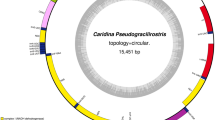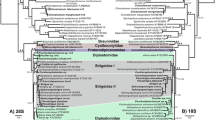Abstract
Partial large subunit 28S rDNA sequences were obtained for specimens of Calicotyle (Monogenea: Monocotylidae) from eight different host species distributed worldwide to test the validity of some species and to address the question of host-specificity in others. Sequences obtained for Calicotyle specimens identified as C. kroyeri based on morphological methods from the type-host Raja radiata (Rajidae) and an additional host R. clavata, both from the North Sea, were identical. However, `C. kroyeri' from the cloaca of R. naevus from Tunisia, Raja sp. A from Tasmania and R. radula from Tunisia differed from C. kroyeri from R. radiata by five (0.51%), 21 (2.13%) and 39 (3.96%) base pairs, respectively, over 984 sites. Therefore, it is likely that the specimens from Raja sp. A, R. radula and perhaps even from R. naevus are not C. kroyeri. Molecular results determined that the calicotylines from the cloaca of Urolophus cruciatus and U. paucimaculatus (Urolophidae) from southern Tasmania identified previously as C. urolophi are indeed identical. Large subunit 28S rDNA sequences of C. palombi and C. stossichi collected from the cloaca and rectal gland, respectively of Mustelus mustelus (Triakidae) from the coast of Tunisia differ sufficiently for these calicotylines to be considered separate and valid species. Our results indicate that some species of Calicotyle are not strictly host-specific, but that C. kroyeri may not be as widely distributed in rajids as was believed previously. Calicotyle specimens from rajids must be re-examined critically to determine whether there are morphological differences indicative of specific differences that may have been overlooked previously.
Similar content being viewed by others
References
Branstetter, S. (1984) Triakidae. In: Whitehead, P.J.P., Bauchot, M.-L., Hureau, J.C., Nielson, J. & Tortonese, E. (Eds) Fishes of the North-eastern Atlantic and the Mediterranean. Volume 1. Paris: UNESCO, pp. 117-121.
Chisholm, L.A., Beverley-Burton, M. & Last, P. (1991) Calicotyle urolophi n. sp. (Monogenea: Monocotylidae) from stingarees, Urolophus spp. (Elasmobranchii: Urolophidae) taken in coastal waters of southern Australia. Systematic Parasitology, 20, 63-68.
Chisholm, L.A., Hansknecht, T., Whittington, I.D.& Overstreet, R. (1997) A revision of the Calicotylinae Monticelli, 1903 (Monogenea: Monocotylidae). Systematic Parasitology, 38, 159-183.
Dawes, B. & Griffiths, I. (1958) The enigmatical trematode Dictyocotyle coeliaca. Nature, 182, 1,033-1,034.
Dawes, B. & Griffiths, I. (1959) Relationship between Dictyocotyle and Calicotyle. Nature, 183, 835-836.
Euzet, L. & Williams, H.H. (1960) A re-description of the trematode Calicotyle stossichii Braun, 1899, with an account of Calicotyle palombi sp. nov. Parasitology, 50, 21-30.
Hall, T.A. (1999) BioEdit: a user-friendly biological sequence alignment editor and analysis. Computer program distributed from the Department of Biology, North Carolina State University.
Hassouna, N., Michot, B. & Bachellerie, J.P. (1984) The complete nucleotide sequence of mouse 28S rRNA gene. Implications for the process of size increase of the large subunit rRNA in higher eukaryotes. Nucleic Acids Research, 12, 3,563-3,583.
Kearn, G.C. (1970) The oncomiracidia of the monocotylid monogeneans Dictyocotyle coeliaca and Calicotyle kroyeri. Parasitology, 61, 153-160.
Kearn, G.C. (1987) The site of development of the monogenean Calicotyle kroyeri, a parasite of rays. Journal of the Marine Biological Association of the United Kingdom, 67, 77-87.
Last, P.R. & Stevens, J.D. (1994) Sharks and rays of Australia. Australia: Publication of CSIRO Division of Fisheries, 513 pp.
Lawler, A.R. (1981) Zoogeography and host-specificity of the superfamily Capsaloidea Price, 1936 (Monogenea: Monopisthocotylea). An evaluation of the host-parasite records of the superfamily Capsaloidea Price, 1936, and their utility in determinations of host-specificity and zoogeography. Special Publications in Marine Science, Virginia Institute of Marine Science, 6, 650 pp.
Llewellyn, J. (1959) Relationship between Dictyocotyle and Calicotyle. Nature, 183, 835-836.
Llewellyn, J., Green, J.E. & Kearn, G C. (1984) A checklist of Monogenean (Platyhelminth) parasites of Plymouth hosts. Journal of the Marine Biological Association of the United Kingdom, 64, 881-887.
Stehmann, M. & Bürkel, D.L. (1984) Rajidae. In: Whitehead, P.J.P., Bauchot, M.-L., Hureau, J. C., Nielson, J. & Tortonese, E. (Eds) Fishes of the North-eastern Atlantic and the Mediterranean. Volume 1. Paris: UNESCO, pp. 163-196.
Swofford, D.L. (1998) PAUP: Phylogenetic analysis using parsimony version 4.0b4 (PPC). Sunderland, Massachusetts: Sinauer.
Szidat, L. (1970a) Descripción de una neuva especie de la subfamilia Calicotylinae Monticelli, 1903. Paracalicotyle asterii, n. g., n. sp., del Cazón (Mustelus asterias Rhond. Clouquet) del Atlántico Sur (Trematoda, Monogenea). Neotropica, 16, 53-57.
Szidat, L. (1970b) Neuvas investigaciones sobre la subfamilia Calicotylinae (Monogenea) y una neuva especie de Austrocalicotyle Szidat 1971. Anales del Instituto de Biología Universidad Nacional Autónoma de México (Serie Zoologia), 41, 155-160.
Thompson, J.D., Higgins, D.G. & Gibson, T.J. (1994) CLUSTAL W: improving the sensitivity of progressive multiple sequence alignment through sequence weighting, positions-specific gap penalties and weight matrix choice. Nucleic Acids Research, 22, 4,673-4,680.
Timofeeva, T.A. (1985) [Morphological and ecological aspects of evolution in the Monocotylidae (Monogenea)]. Parazitologicheskii Sbornik, 33, 44-76. (In Russian).
Whittington, I.D. & Kearn, G.C. (1993) A new species of skinparasitic benedeniine monogenean, with a preference for the pelvic fins of its host, Lutjanus carponotatus (Perciformes: Lutjanidae) from the Great Barrier Reef. Journal of Natural History, 27, 1-14.
Whittington, I.D., Kearn, G.C. & Beverley-Burton, M. (1994) Benedenia rohdei n. sp. (Monogenea: Capsalidae) from the gills of Lutjanus carponotatus (Perciformes: Lutjanidae) from the Great Barrier Reef, Queensland, Australia, with a description of the oncomiracidium. Systematic Parasitology, 28, 5-13.
Author information
Authors and Affiliations
Rights and permissions
About this article
Cite this article
Chisholm, L.A., Whittington, I.D., Morgan, J.A. et al. The Calicotyle conundrum: do molecules reveal more than morphology?. Syst Parasitol 49, 81–87 (2001). https://doi.org/10.1023/A:1010629022955
Issue Date:
DOI: https://doi.org/10.1023/A:1010629022955




